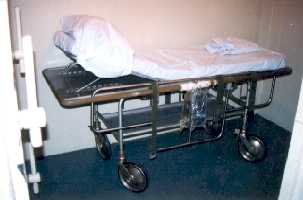|
Velma Marge Barfield. |
 Velma Barfield made international headlines when she became the first
woman to be executed in
Velma Barfield made international headlines when she became the first
woman to be executed in
She was put to death at
Velma was addicted to drugs, not the hard drugs like heroin or cocaine, but
rather prescription drugs such as tranquilizers, sleeping pills,
anti-depressants and barbiturates. Her addiction stemmed from a nervous
breakdown and she had a history of overdosing and subsequent hospital
treatment, with four admissions between 1972 and 1975.
Background.
She was born on
Her limited employment opportunities could not support her drug habit so she
took to forging cheques and then killing the people
she had defrauded.
The crimes.
By 1977 she was in a relationship with Stuart Taylor who was a widower and
tobacco farmer. As usual, she forged checks on
At the trial, her defense pleaded insanity but this was not accepted and she
was convicted. The jury recommended the death sentence. Velma appeared cold and
uncaring on the stand and actually gave the District Attorney a round of
applause when he made his closing speech.
She subsequently confessed to the murders of
her mother in 1974 (in whose name she had taken out a loan) and of two elderly
people, John Henry Lee by whom she was being paid as a housekeeper/carer and Dollie Edwards through
whom she met Stuart Taylor (he was related to Dollie).
Velma always attended the funerals of her victims and appeared to grieve
genuinely for them.
Her late husband, Thomas's body was later exhumed and also found to contain
traces of arsenic but Velma denied that she had killed him.
Her motives for these four murders were the same. She had misappropriated money
from her victims and then according to her, tried to make them ill so she could
nurse them while finding another job to enable her to repay the money. Needless
to say, the jury was less than impressed by this defense.
Death row.
On death row at
She became a "born again" Christian while awaiting trial and during
the next 6 years that she spent on death row did a lot to help and counsel
other female inmates. Appeals to save her dragged on through various courts and
there were many representations on her behalf by religious leaders. Her final
appeal was filed on
It is claimed by some, that Hunt could not reprieve her without looking
"soft" on crime during the run up to the state elections in 1984.
She began to accept her death and instructed her attorney, Jimmy Little, to drop all appeals the day before she was due to be
executed saying that she wanted to "die with dignity." She clearly had little fear of what lay ahead
and is quoted as saying "When I go into that chamber at
Execution.
Under
She dressed in her own pink pajamas for the execution and was made to wear a
diaper. A stethoscope and heart monitor were taped to
her chest. The wheeled gurney (see below) was taken to her cell and she was
secured to it with straps over her body and legs. Catheters were inserted into
her arms and a saline drip started before she was wheeled into the execution
chamber a few minutes before
 Three syringes were attached to each of the IV lines
and these were operated by three volunteers. One of the IV lines was, in fact,
a dummy so that none of the three volunteers could be sure if he had actually
killed her or not.
Three syringes were attached to each of the IV lines
and these were operated by three volunteers. One of the IV lines was, in fact,
a dummy so that none of the three volunteers could be sure if he had actually
killed her or not.
She was pronounced dead at
Conclusion.
So was Velma Barfield a monster and serial killer or just a poor demented soul
whose brain was befuddled by drugs and who always needed more money to pay for
them? My own answer is somewhere in between. As many before her she, no doubt,
found that murder came quite easily once she had committed the first one and it
offered a simple and permanent solution to the problem of being found out by
those she was defrauding.
Visit http://www.doc.state.nc.us/DOP/deathpenalty/executio.htm for more information on